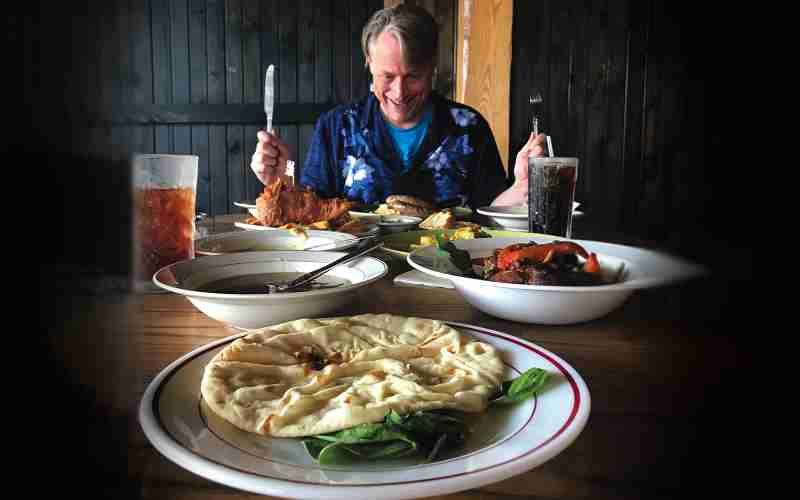Somehow, I had reached the age of 55 without sampling the cuisine of my people.
Which people? Why, the British people, of course.
The Penhollows (then called the Penhallows) came to New England from Cornwall sometime in the years before the United States was a country, before it was united, and before it consisted of states, but after it had consisted mostly of non-Europeans.
I have always loved British writers, comedians, and musicians, but I have tended to steer clear of their chefs.
That’s not to suggest that British chefs followed me around trying to cook me things. I got them to stop, but only after they were threatened by lawyers from Society for the Prevention of Nonconsensual Cooking.
When I was a boy, my knowledge of British food was rudimentary. I knew just enough to be frightened. I’d heard a rumor to the effect that cakes are called puddings in England. Additional rumors: that puddings are called custards, fries are called chips, and chips are called crisps.
Even worse, I’d been led to understand that they put meat in pies and blood in puddings.
I was a sensitive lad who had to follow a strict dietary regimen that limited me to anything that could be put between two slices of white bread and anything that could be pulled out of a box marked Hostess.
I didn’t eat blood-based meals, although I did suck on my thumb when I’d accidentally cut it. I also sucked my thumb when I hadn’t accidentally cut it. I sucked my thumb for 20 years before I was able to quit. I lasted 10 minutes before I was able to restart.
Bad Reputation
I wasn’t alone in my fear of, and ignorance about, British food. It had an internationally and irrationally bad reputation through much of the 20th century.
Even into the late 1990s and the early 2000s, public figures were disparaging British food in public ways.
After she returned to the states from a movie shoot in England, actress Gwyneth Paltrow said, “Britain is beautiful and refined and polite and all that nonsense, but the food is so bad, I couldn’t wait to get home.”
British chefs were incensed but none of them thought to respond, “Someone who makes a candle like you do really shouldn’t criticize people who make food like I do.”
On several occasions while he was President of France, Jacques Chirac accused England of committing food crimes. Then he was convicted of committing actual crimes, which really put the whole food crimes thing into perspective.
British Mystery
I had to get to the bottom of this (meaning, find out the truth about British food, not the truth about Chirac’s crimes)
So I called up my friend Jaclyn — who has helped me get to the bottoms of many things, especially wine bottles — and asked her if she’d be interested in visiting Payne’s in Gas City.
Payne’s is the only Hoosier restaurant north of Indianapolis that specializes in British cuisine.
It was originally opened as an ice cream shop by Stephen Payne.
Payne was born in Hitchin, about 40 miles north of London. He originally came to the States because he was obsessed with American pop culture.
His love of James Dean brought him to Fairmount. Now he is bringing quintessentially British dishes to Indiana.
Before we’d even arrived at Payne’s, I had decided to do something unusual: Order pretty much everything on the menu.
It sounded gluttonous, but I reasoned that Payne’s kitchen couldn’t possibly occupy more than one or two rooms. Henry the Eighth’s kitchen filled 51 rooms!
“It will be a long time before I join Henry the Eighth on a list of History’s Greatest Gluttons if I limit myself to kitchens of 10 or fewer rooms,” I thought.
From Curry to Cock-a-leekie
We started with chips and curry sauce, aka curry chips. Curry chips are French fries with a curry-infused gravy.
It’s not the Indian curry that burns your tongue off. It’s a milder curry that caresses your tongue like a tongue masseuse would.
I am sure you know what I am talking about.
We ordered four soups including cock-a-leekie. Cock-a-leekie is Scotland’s version of onion soup. Americans who laugh at the name throughout their childhoods are always disappointed to find out the soup is innocuous as it is.
But tasty. All the soups at Payne’s were as tasty as any soups that Jaclyn and I could remember enjoying.
Jaclyn and I visited Payne’s in the summer, but you’re reading this in the fall, presumably.
Autumn is soup-eating weather and if you are a soup-eating autumn aficionado or an autumn-eating soup aficionado, the soups at Payne’s are worth a special trip.
So are the fish and chips.
If your childhood was anything like mine, dinner on Friday nights consisted of fried fish and French fries purchased from some locally owned restaurant in your town.
The fish tended to be heavy and soggy and that was OK with me. I didn’t know any better.
The fried fish at Payne’s is so light, it almost floats off the plate. It tastes like a reinvention of fish and chips. But since Americans probably reinvented the British dish when they made it heavy and soggy, the fish and chips at Payne’s just made me sad for my younger self and all those leaden Friday meals he had to gulp down.
Don’t worry. I have been working through my grief. I found a therapist who specializes in fish and chips trauma.
Everything we ate at Payne’s was superlative. Jaclyn is a foodie and avid restaurant-visitor and even she was impressed.
We ended with the sticky toffee pudding, which was delicious, although Jaclyn had to keep reassuring me that there was no blood in it.
I wasn’t quite convinced, so — between bites — I sucked my thumb.




